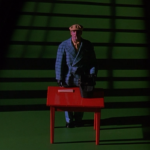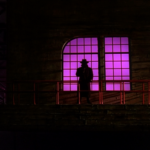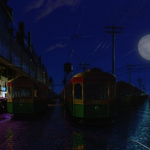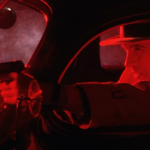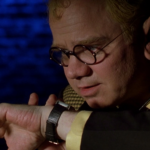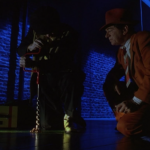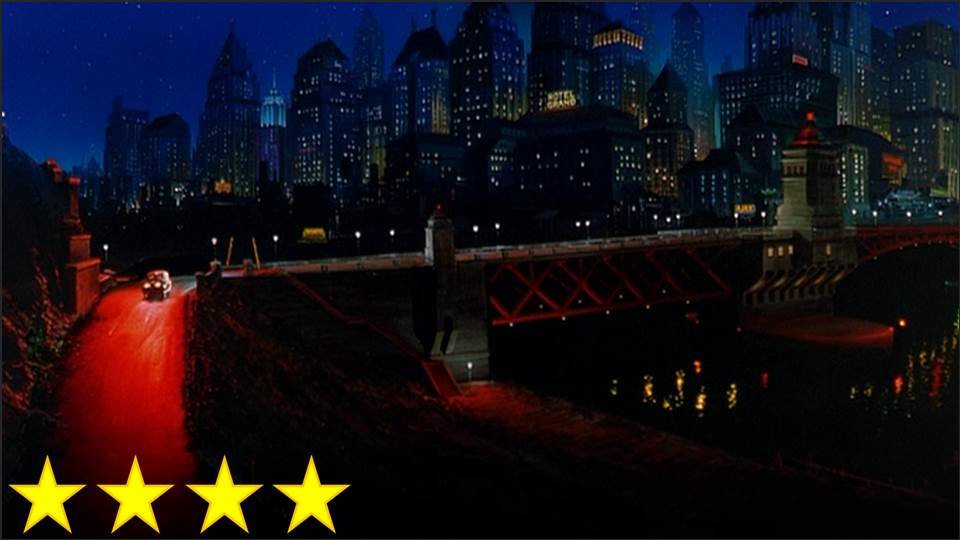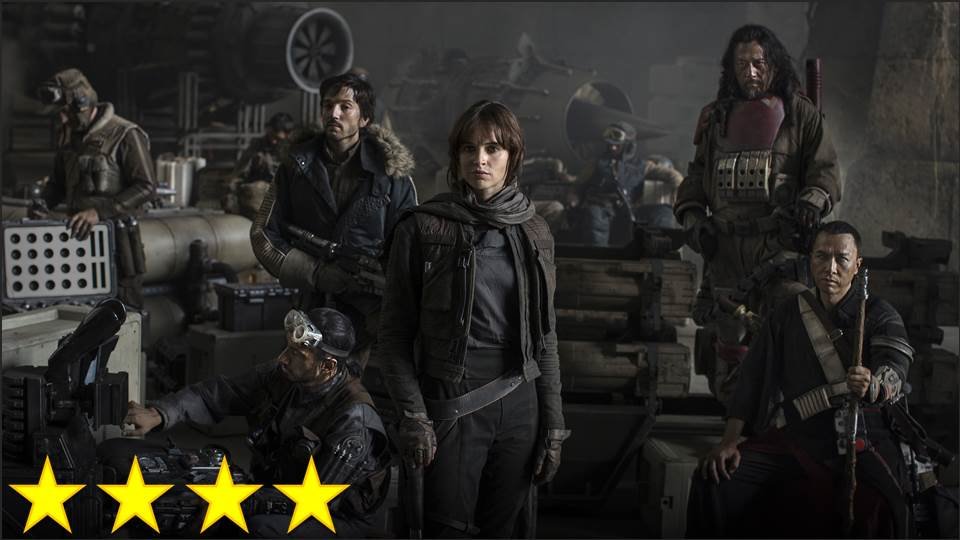This movie is extremely different from what I was expecting, which is odd since my expectations were neither rigid nor conventional, so I should have been a tough audience to surprise. Ralph Bakshi, however, is full of surprises, and his creativity knows no bounds. Unfortunately, creativity sometimes needs some constraints in order to be understandable to those who are not the thinker, and Wizards lacks the lucidity it requires. The best example of this is how the film suggests an army in a fantasy world improves its performance simply by watching a projected film reel of Nazis to get pumped up, without any understanding of the Nazi party’s tenants. It’s a strange idea, but the way it is expressed visually makes it stranger: the reel isn’t projected onto any particular space, instead appearing behind the army as though the Nazi film filled the air and/or the soldiers in the fantasy world were becoming part of the film. This isn’t simply a matter of openness of interpretation – this is cinematically illegible, and it is typical of the rest of the movie, which seems to follow dream logic more than narrative logic and expects the audience to buy into many unexplained, confusing plot points. When this is combined with the bizarre characters, unsettling sexual imagery, and poorly executed climax, the result is a film that, in spite of its inspired artistry, has little substance and no coherence, making it regrettably difficult to tolerate.
Action & Adventure
The Goonies Review
From the Traveling Wilburys to Band Aid, the pop music industry has had its share of super groups, but for whatever reason, cinema hasn’t. For whatever reason, while talented directors have worked together before, we very rarely see a group of different directors with different backgrounds coming together to work on a groups of films as a team. I think this begs the question: what would a filmmaking super group look like? Because I’m fond of ’80s cinema, I’d like to imagine something like a family adventure film with a story by Steven Spielberg, with a screenplay by Chris Columbus (the writer of Gremlins, director of Home Alone), with music by Dave Grusin (composer for Tootsie), and someone like Richard Donner (director of Superman, Ladyhawke, Lethal Weapon, and Scrooged) at the helm. Fortunately, this is exactly the team assembled for this movie, and what this team produced is just as great a film as one would hope.
I think part of why Goonies is considered to be such a great classic by so many people is that it is very emblematic of ’80s cinema. Even with a cast of children, the intended age group is entirely unclear because of how dirty some of the humor is, making it a family film in the same category as Ghostbusters in that it’s not really a family film. It’s also a very good example of Spielberg’s conception of fantasy, giving the viewer the sense that something sort of magical might be found at that old Chinese antique shop, or, in this case, up in the attic. The most ’80s part, of course, is the theme song by Cyndi Lauper, and the music video that was made to accompany it. Somehow, even though that video is entirely different from the film, the combination of the two sums up everything that made the ’80s the ’80s, and I think that’s just beautiful.
Once I started watching this movie, it was hard to pause it – and I can say that for very few films – so I think The Goonies, as dated as it may be in some respects, just might be pure entertainment cinema at its very best.
Legend (1985) Review
I usually avoid explaining the plots to films in my reviews, but just this once, here’s my summary of the story of Ridley Scott’s Legend:
The beautiful Princess Lily is never seen in her castle, nor do we ever see her royal parents, for some reason. Instead, she prefers to spend her time with the lower class or out in the woods for some reason. Lily is a completely innocent girl, yet she likes to pull cruel tricks on friends of hers for some reason. She’s madly in love with a boy named Jack for some reason, and he’s a wild, beastly jungle boy who likes to be among nature and talk with the animals for some reason. Jack decides to take her to see some unicorns, which are very rare creatures for some reason, but then she decides to touch one for some reason. Unicorns must never be touched by mortals – even innocent mortals like Lily – for some reason. She touches it anyway, and in her pride, she challenges Jack to retrieve her ring from the bottom of a deep pond so that he may earn the right to marry her … for some reason.
Meanwhile, a devilish character named Darkness is forced to live down below in the shadows (with limited power) during a period of goodness and light for some reason. He sends his servants to kill and de-horn the only two living unicorns, which will give Darkness his power back for some reason. Then an elf shows up to yell at Jack for some reason, and in one version of the film, he challenges Jack to solve a riddle for some reason. Then the elf says that Jack specifically, a jungle boy he just met and knows nothing about, has to be the hero who goes to the castle of Darkness to save the unicorn, for some reason – and I really would have liked this reason explained to me. Then a little fairy, whom the elf assumed was just a formless, bodiless ball of light for some reason, reveals herself to be … well, a real fairy with a body and wings and all that, but she makes Jack promise not to tell anyone, for some reason – and I really would have liked to have all this explained to me. Then she wants him to kiss her for some reason? And then Lily dances with her sin for some reason as Darkness walks out of a mirror for some reason and reveals that he’s in love with her for some reason?
I know it sounds like this must all make sense in the film. It sounds like most of this would just seem perfectly natural and unquestioned in context, but there isn’t much context. In fact, the theatrical cut – the version of the film the studio made to keep people from getting too confused – is more confusing because it has less context. I understand more about these characters in the director’s cut just because it adds little scenes that give them more dialogue, even when their dialogue isn’t particularly important to the plot. The director’s cut is unfortunately lacking in some scenes that strengthen the film, including a better ending, but overall, it makes a little more sense. It’s still pretty darn weird, and I often have no idea what the director’s trying to do, but it makes a little more sense – unless I just felt like it did because it was my second time watching the movie within a few days. (The director’s cut also has a score that’s surprisingly a bit better – the theatrical version has a cool ‘80s synthesizer score by an electronic band, which I thought I would love, but the director’s cut’s orchestral score by Jerry Goldsmith uses an unusual amount of synth as well.)
With this said, I should clarify that this movie is, somehow, really cool. That’s the best adjective to describe it – “cool.” It feels like I’m seeing something fascinating, captivating, hypnotic, artistic, impressive, innovative, and a little bit naughty in nearly every scene. The problem is that these scenes don’t connect well together. If watched with the American version of the soundtrack, filled with synth music, the movie might as well be a compilation of ‘80s music videos, because it has that same kind of aesthetic and that same amount of narrative. It’s safe to say that, if my introduction to the film had been a video clip from any individual scene on YouTube, I would immediately be very eager to watch the whole film because of how awesome it looks, sounds, and feels, not realizing that the context of each scene does not enhance its power in the slightest.
This film has no psychological or emotional logic to it, and it hardly makes sense according to surrealist “dream logic.” While it remains a cult classic because of how it sticks with the people who watched it as kids, and its imagery is indeed difficult to forget even for adult viewers, it has never been hailed for its story – it hardly has one. It lacks drama, tension, or any sort of emotion because its pieces feel so arbitrary no matter how they’re put together. Obviously, I don’t ask to have everything explained to me in detail like in Dark City, nor do I ask for everything in a story to be logical, but it is almost impossible for an audience to become invested in a story if it has bland, lifeless characters that act without clear motivations, scenes that take place without clear purposes, events that unfold without clear causes, and rules that must be followed without clear logic to them. Other films can get away with a sense of arbitrary anarchy because of a fast pace and/or a sense of intense urgency, such as Big Trouble in Little China, but even with a vague “ticking clock” scenario, Legend never instills the right kind of empathic anxiety in the viewer. Because of its immensely pleasing artistry and its successful transportation and immersion of the viewers into its distinct, yet familiar, fantasy world, it works very well as a film – just not as a movie.
The LEGO Batman Movie Review
SPOILER WARNING
This film’s strengths and weaknesses both pertain to the issue of “heart” in film.
If not for the fact that this is a spin-off of The LEGO Movie, the writers would have been free to simply fill the entire film with fun Batman jokes and absurd mix-ups and lunacy that only make sense in an animated comedy. The LEGO Movie, however, has a lot of heart to it that tied the film together nicely and offered a solid foundation for its comedy. I argue that LEGO Movie is probably one of the better examples of heart done well because, by that point in the movie, it feels needed and welcomed, as opposed to being forced down our throats at the very beginning like in other family films. I often think back on an argument between Siskel and Ebert (which I explained in my Scrooged review) in which Gene Siskel said Back to the Future II should have stopped to take the time to add more heart. I think this is a fairly stupid position to hold seeing as how a movie should really bring in heart at times when it is necessitated by (and it necessitates) the story, but unfortunately, The LEGO Batman Movie makes its heart-warming scenes feel almost out of place, even though they inform much of the story and supply the main character motivation. Somewhere in the crazy, convoluted mess that was the writing process for this film – consisting of a grand total of five people getting screenwriting credits – the story kept getting reworked until the final result felt like certain scenes were in the script simply to satisfy a “kids movie checklist” of some sort, and most of the bullets on the list pertained to grabbing the heartstrings. Since I watched this film in a theater filled with children, it was very easy to tell that these scenes simply did not succeed at grabbing the audience.
The rest of the movie, however, is filled with the best kind of heart: passion. LEGO Batman is one of those films with the rare quality of feeling like a great fan project was given a Hollywood budget and free range. The film may be loaded with fan-service and a little too dependent on the laughability of previous incarnations of Batman, but it just loves its world and its characters so much that the passion is infectious. The beauty of the thing, of course, comes from the fact that this is a LEGO-based film, so it can do things with Batman that couldn’t work with the real Batman, and that couldn’t work with a parody, but work perfectly in the space in between. After all, who doesn’t want to see the Dynamic Duo fight off the gremlins, the Joker recruit Godzilla, or freaking Voldemort casting spells in the Bat Cave? In a Batman movie that audiences took somewhat seriously, this would enrage people, and in a YouTube parody, it wouldn’t have much power or meaning, but in this movie, it is both official and non-canon at once. Consequently, the writers were able to put Batman against all of his greatest enemies at once at the start of the movie, making the audience wonder where on earth they could possibly go from there, and then live up to that question by raising the stakes to a level that we never knew could be part of the game. The movie somehow managed to bring back so much classic Batman material dating back to the 1940s (including an obscure villain played by Vincent Price on the 1960s series) and bring in great new material (Batman vs. King Kong, a touching Batman/Joker bromance, etc.) without feeling overcrowded.
My one regret is that the theater didn’t have more excited, happy Batman fans in it to laugh with me. Please see it with friends and have a good time.
Dick Tracy Review
In my experience, if a story and its characters are good enough, I can forgive many aspects of a film that seem lacking. I can forgive the forgettable music scores and relentlessly bland visuals of most contemporary films so long as I’m invested in what the characters are trying to do. For this reason, I’ve held the position for many years now that a film’s cinematography, choreography, mise en scène, color scheme, lighting, score, attention to detail, use of the camera for visual storytelling, and even (to some extent) acting are not sufficient reasons to consider a film great – it is the content that matters. As an intellectual who looks at cinema as a communication medium, this makes sense – great presentation of a bad idea is still a bad idea – so I usually have had no problem appreciating the impressive aspects of a visually pleasing film (see Carousel) or even a film with excellent performances (see American Hustle) while still hating the movie. However, as I have long feared it would, Dick Tracy has challenged this perspective: the main character, the plot, and seemingly the directing (at least in some respects) are all sub-par at best, but with its stylistic excellence, I cannot help but love this movie with all my heart.
In my attempts to find a way to justify my arguments with my feelings as I’ve thought about what to write for this review, one thought that keeps recurring is how similar this film seems to The Dark Crystal. Here we have a creative producer who has taken on the task of directing a passion project of his with a visual style that no one has ever seen before, even going so far as to play the lead himself to ensure that everything is done right, and yet something is still very wrong here. Dick Tracy is just not a likable character, Madonna doesn’t work all that well for the particular kind of sexy that’s required of her, and somehow the very simple plot seems too complex to follow. Even stylistically there are problems, especially because of the pacing. It’s incredibly jarring to see the big scene in which Tracy goes and catches a bunch of bad guys, knocking people out all the while, as a very slow jazz song plays over it. Weirdly though, the fact that it is terrible almost makes it better – I think this belongs in the category of “génial–nanar blends” These are films that are sometimes so bad that they’re good, and other times so good that they’re great (and occasionally they’re all of these at once).
I think this is a fair case because of just how many strong elements this film has. I cannot emphasize enough that most of the cast is excellent. The cameos kept surprising me, although they sometimes seemed awkward – consider Colm Meaney (Miles O’Brien of the Star Trek franchise) as one example, who appears in the background as a police officer in one scene and is easy to miss if the viewer isn’t paying attention. Dick van Dyke is as delightful as always, Al Pacino is perfect for his part, and Dustin Hoffman had me in hysterics with his unique performance. For the most part, however, what makes the characters work so well is the way they look. The make-up and costumes are very much deserving of the awards they’ve won, and the kinds of faces that appear in this movie simply aren’t in any other films at all – this look distinctly belongs to Tracy’s world. While I could easily put together an image gallery that showcases the make-up, I’ve decided not to do that because I don’t want to give that away for any readers who may not have seen the film. I do, however, want to show off some of the shots that are cool simply because of the lighting, colors, sets, backgrounds, and camerawork, just to back up my case that this is the best-looking film ever made. For a taste of what this film’s visual style has to offer – and I’ve only pulled from a particular section in the middle so the rest of the movie’s visuals aren’t spoiled – enjoy the following gallery:
By this point, it should be fairly easy to see why I love this movie, but I want to make it clear that I still don’t think I’m straying too far away from the theoretical principles to which I have claimed to be subscribed. To me, an interesting story involves following a character who’s in a fascinating situation, and usually what makes the situation interesting is how the character clashes with his/her context. Here, the situation of being in this kind of warped world with such strange characters is so interesting that virtually any character, no matter how uninteresting, can make this film captivating, as long as he/she is reasonably consistent as a character. I can’t stand films that try to present an imaginative world in an objective and emotionally distant way, such as 2001: A Space Odyssey, but a film with an immersive and captivating world (see Dark City) invites the viewer to explore it and get wrapped up in it, which makes full use of cinema in its purest form: transportive simulation. Perhaps more importantly, however, is the appeal that comes from a different story that the film reflects, which is the story of its own construction. This film offers a way to watch a director struggle to create the kind of world that his film needs, and the mix of powerful successes and unbelievable failures gives the film a very cinematic sort of drama. This tension in the film is just enough of a story of its own for the needs I expressed in the first paragraph of this essay to be appeased, making for a very enjoyable movie experience.
Also, I truly do consider this to be, in terms of visuals only, the greatest film ever made, and I would appreciate it if any readers challenged that by offering an example of a film that looks even better. This is not a request, but a dare. Please accept it.
Rogue One Review
MINOR SPOILER WARNING
By the end of 2016, it seemed as though everyone on the Internet was in the mood to rant about how every movie Hollywood makes is a sequel, prequel, remake, reboot, or in-universe story. This, of course, is not true – just watch the previews before one of the big hit dramas out in theaters today or check the homepage of Rotten Tomatoes. Still, there is definitely a movement in cinema right now towards returning to the many stories it has told and trying to find something new here, to varying degrees of success. Instead of relying just on the genre system that guided Classical Hollywood, which was essentially a means for the studios to make money by telling the same story over and over again, the ’80s have given us a blockbuster and franchise system, which is now moving further from focusing on original stories and towards revisiting familiar stories. Perhaps the various modern twists on fairy tales are responsible for this obsession with re-visitation, and maybe Wicked is to blame for that trend, but regardless of the cause, I don’t think this is necessarily a bad thing. This just means that audiences have to learn to approach stories differently, particularly when dealing with in-universe stories that aren’t focused on the main characters from the original franchise. This didn’t seem to be a problem for most people who saw Fantastic Beasts, but surprisingly, it has made Rogue One: A Star Wars Story a very divisive film.
I think it’s safe to say that there are very few other films in history that have been designed specifically to both contextualize and by contextualized by another film on the level that Rogue One is. This is very new for cinema, but it isn’t for Star Wars – they’ve had TV shows in this universe that were inspired by a single (almost insignificant) line of dialogue from New Hope, so this shouldn’t seem that strange to people. Yet, somehow, the lack of an opening crawl is too much for some people to handle. For me, it doesn’t matter whether or not it feels like a Star Wars movie, or even a Star Wars story, so long as I believe that it’s in the same universe as Star Wars and its story makes me look at the main films with greater understanding and appreciation of their context. This is all true for me, so any reservations I might have have been appeased, allowing me to focus just on enjoying the story.
So is it a good story? Well, at the very least it feels like an original story. This is one quality that other films in the franchise have not had, much to their detriment. The villains and side-characters are all great, but the two leads are fairly uninteresting. I will say that I understood the protagonist’s perspective throughout, rooted for her, and could tell that she was not one to be trifled with – she was fierce. Each of the characters serves his/her purpose, the drama is intense, the humor is hilarious, the action is more awesome and impactful that most of the action scenes I’ve ever seen, and the story plays with elements of the Star Wars universe well. (Also, Vader is amazing, his first appearance sending chills down my spine, and his second blowing me away.)
With all this in mind, I have a difficult time understanding why so many people I know have been so disappointed. This movie has the perfect balance of serious war themes and fun excitement. Just imagine if a good fan project was given a huge load of money and told to go crazy. That’s the feeling of this movie. Because of how much it seems like a fanatic’s passion project, it really feels like a victory for the fans. This is enough to make it satisfactory, but with the added bonuses of clever references to other characters and an amazing ending, it’s very pleasing. Sure some of the CGI is terrible, but I still see this as a film that is paving the way to great things in cinema’s future, and for that I greatly appreciate it.






